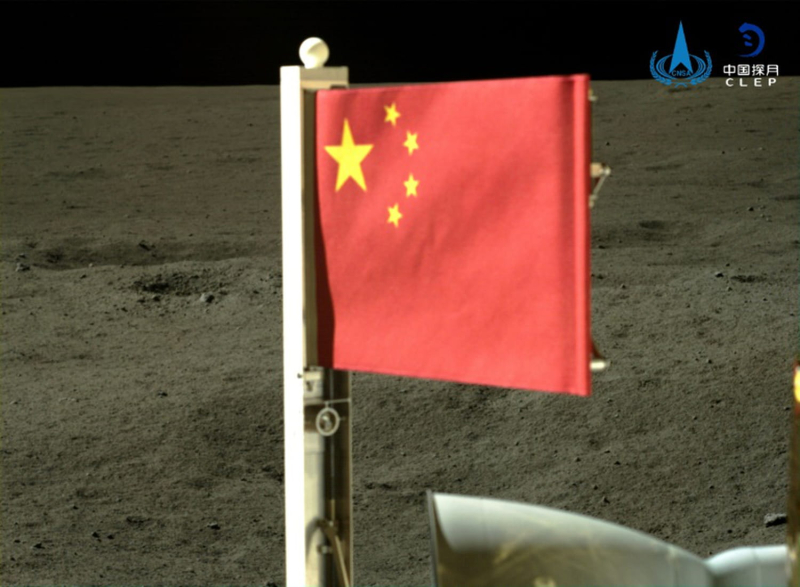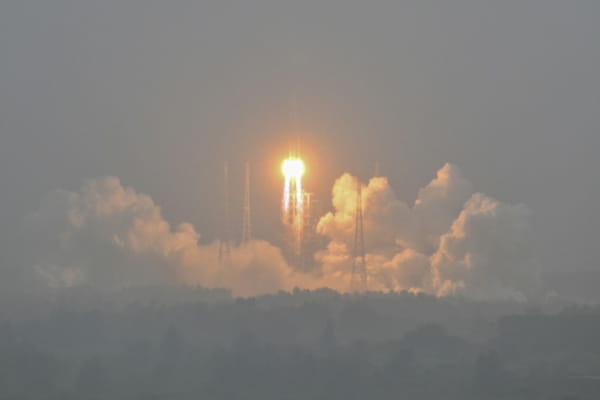The ascent module of the Chinese Chang'e-6 probe took off successfully from the lunar surface on Tuesday and carried away samples of the hidden face, a world first, announced the Chinese Space Administration. This announcement marks a new step in China's ambitious space program, which aims to send a manned mission to the Moon by 2030. The ascent module “of the Chinese probe Chang'e-6 took off from the lunar surface Tuesday morning carrying samples collected on the far side of the Moon, an unprecedented feat in the history of human lunar exploration” , indicated the official Xinhua news agency, citing the Chinese Space Administration (CNSA). This is “an unprecedented feat in history of human exploration of the Moon', stressed the space administration, and “the mission withstood the test of high temperatures on the far side of the Moon”. < p>After takeoff, the module “entered a predefined orbit around the Moon”, added the CNSA. Chang'e-6 landed Sunday in the vast South Pole-Aitken basin, one of the largest known impact craters in the solar system, located on the far side, according to the space administration. The probe's mission, scheduled to last 53 days, began on May 3, with the aim of collecting samples. For this purpose, it has a drill to retrieve samples from beneath the surface, and a robotic arm to grab material directly from the surface. – “Very proud” – After successfully collecting samples, “a Chinese flag carried by the lander was deployed for the first time on the far side of the Moon,” Xinhua reported. Scientists believe that the far side of the Moon – a rarely explored region, so called because it is invisible from Earth and not because it never captures the Sun's rays – holds great promise for research because its craters are less covered by old lava flows than those on the visible side. Samples taken from the far side could allow us to find out more about the formation and the history of the Earth's natural satellite. They will also make it possible to better understand “the origin of the solar system” and to better prepare for future explorations, underlined a spokesperson for the Chang'e-6 mission, Ge Ping, quoted by the Xinhua news agency. The Chinese space agency has not provided information on the continuation of the mission. A Long March 5 rocket, carrying the Chang'e-6 lunar probe, takes off from the Wenchang Space Launch Center in south China's Hainan province, May 3, 2024 © AFP – Hector RETAMAL According to specialized sites, the samples should remain in lunar orbit for a few weeks before beginning their return to Earth around June 25. “As a Chinese, I am very proud of my country's breakthroughs” in lunar exploration, Mr. Liu, a 23-year-old designer met in the streets of Beijing, told AFP. “I think that Chinese astronauts will be able to land on the moon in the next decade,” said the young man who did not wish to give his full name. – Humans on the Moon – China hopes to launch its first manned mission to the Moon by now 2030. It also plans to build a lunar base. The Chang'e-6 mission is part of China's ambitious lunar program.< /p> Among his main feats of arms, he succeeded in safely landing a device on the far side of the Moon in 2019 – a world first. In 2020, he also brought back lunar samples, from the visible side of the star, which was a first for a country in more than 40 years. China has significantly expanded its space programs under President Xi Jinping, pumping billions of dollars into the sector in a bid to catch up with leaders in the US and Russia. It has already recorded several successes, notably the construction of the Tiangong (“Heavenly Palace”) space station where a new crew of three astronauts was sent in April. < p>The United States accuses the Chinese space program of hiding military objectives and of wanting to ensure Beijing's domination in space. Washington plans to send astronauts to the Moon again by 2026 with its Artemis 3 mission. bur-smw-ehl-ka-sbr/jnd/phs All rights of reproduction and representation reserved. © (2024) Agence France-Presse


